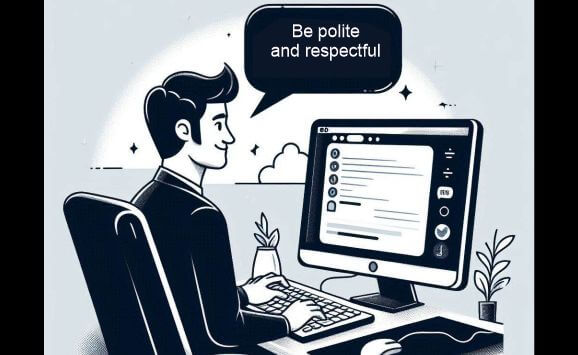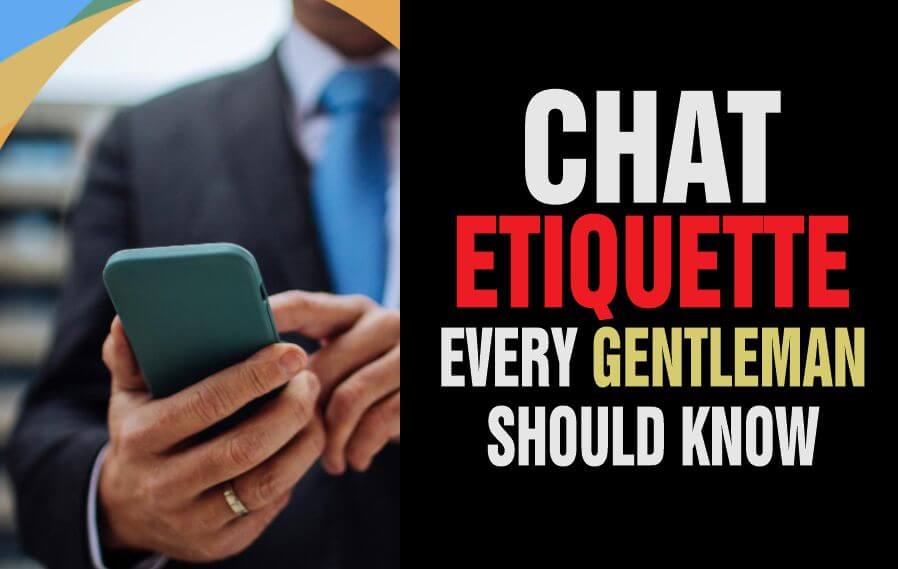Without chat etiquette, you will have a terrible online experience devoid of respect, clarity, and professionalism. Learn to chat online with respect and grace.
Chat etiquette is one of the internet etiquette that has to do with guidelines that ensure compelling and harmonious conversations in the digital space.
By following these essential rules, gentlemen and others can cultivate a positive online presence, encourage healthy relationships, and maintain professionalism while engaging in chat conversations.
Whether it is refraining from using harsh language or responding promptly, understanding virtual chat manners is fundamental in leaving a lasting impression and adhering to social norms in the virtual world.
You might want to pin the image below.

Key Takeaways
- Adhering to chat rules ensures respectful, clear, and professional online interactions.
- Choose your tone based on the context and relationship with the recipient. Use a professional tone for formal settings and a casual one for informal chats.
- Respond promptly to messages and acknowledge receipt to show respect for the time of others whether in personal or professional settings.
- Use emojis and punctuation carefully to convey tone accurately. Avoid sarcasm and irony, as they can easily be misunderstood in written communication.
Table of Contents
- Key Takeaways
- What is Chat Etiquette?
- Types of Chat Etiquette
- Fundamental Principles of Chat Etiquette
- Communication Tone and Style in Virtual Chatting
- Managing Response Time in Online Chats
- Politeness and Courtesy in Chat Etiquette
- Chat Etiquette Examples
- Group Chat Etiquette
- Zoom Chat Etiquette
- Chat Etiquette at Work
- Live Chat Etiquette
- Teams Chat Etiquette
- Text Messaging Etiquette
- Instant Messaging Etiquette
- Frequently Asked Questions
- Final Word from Gentsways
What is Chat Etiquette?
Chat etiquette is the guidelines and rules that should be followed during online conversations, ensuring respectful, polite, and efficient communication. It has to do with being clear and concise with messages, using appropriate tone, respecting the time of others, using proper grammar and spelling to ensure readability, and minding cultural sensitiveness.
Related: Online Networking for Gentlemen
Types of Chat Etiquette

There are two broad types of chat virtual chat manners as described below:
Formal Chat Etiquette
Formal chat etiquette guides chat practices in professional or structured environments like organizations, where communication should be respectful and professional.
You must use proper grammar, complete sentences, and a professional tone in formal chats.
You must address recipients with their titles or names, and eschew from using slang or casual language. Your responses should be timely clear, and relevant.
Formal chat manners also have to do with observing digital etiquette of maintaining privacy and confidentiality, around sensitive topics.
Informal Chat Etiquette
Informal chat etiquette, on the other hand, is the relaxed rules guiding casual or personal conversations, in casual settings like social media or instant messaging platforms.
That it is casual does not mean it is not respectful. Informal chat etiquette allows for the use of emojis, abbreviations, and casual language.
The onus is to keep a friendly and approachable demeanor while being clear respectful, and considerate of the feelings of others.
Related: Email Etiquette for Professionals and Students
Fundamental Principles of Chat Etiquette

Basic principles of chat manners will help to make sure your messages are well-received, understood, and responded to, while you maintain your positive relationship with friends, family, colleagues, superiors, or clients.
Here are the basic principles that guide chat manners:
Clarity and Conciseness
When chatting, always be conscious of clarity. Make sure your messages are conveying the intended meaning by using the right words. Avoid ambiguity and jargon that will confuse the recipient.
Go to the point with fewer words with context and proper details. Also, proofread before sending to eliminate mistakes.
Respect for the Time of Others
The person you are chatting with values their time and you should too. So, avoid wasting their time by keeping your messages clear, relevant, and brief enough.
Avoid too much information at a time, otherwise, it will come off as spam. If you need to share bulky information, break them down into bits.
Employ Proper Grammar and Spelling
While you might feel grammatical and spelling errors are negligible, they pass subtle messages to the recipient about your meticulousness and approach to issues.
Tools like spell check can help identify wrong spellings and suggest corrections.
Related: What is Digital Identity?
Communication Tone and Style in Virtual Chatting

In any type of communication, tone, and style play central roles in how messages are perceived and understood, and online messaging is not exempted.
Whether it’s an email you are writing to your superior or just a casual text to your friend, your tone will impact how your message is received. You should use the right tone for each context.
Let’s take a closer look:
Appropriate Tone for Different Contexts
The situation matters when choosing your tone. For formal settings like work emails or presentations, use a polite and professional tone.
Speak properly, avoid casual language, and keep things serious.
For informal chats with friends and family, you can be more relaxed and casual. Adjust your language based on who you’re talking to.
If you’re friendly with them, you can use humor and personal stories. If you’re not as close, keep things simple and direct.
Avoiding Misinterpretation
Written messages can easily be misunderstood. To show your intended tone, use emojis and punctuation carefully.
A smiley face makes things friendly. Exclamation points show excitement. But don’t overdo it, especially in professional settings. Too many emojis can seem unprofessional.
Be Cautious with Sarcasm
Be careful with sarcasm and irony in writing because they can be easily misunderstood.
What works in a face-to-face chat might confuse someone in a text. When unsure, choose clear language instead of clever phrases to make sure your message is understood.
Related: Online Networking Events and Platforms
Managing Response Time in Online Chats

Understanding how to handle response times and how it affect your relationships can improve your interactions and ensure positive relationships whether professional or casual.
Here is how to manage response time properly:
Timeliness in Responses
Delayed responses to chats can confuse and make the conversation appear dismissive. In online chats, responding promptly to people’s chats is vital to maintain effective communication.
It’s important to indicate how quickly you’ll respond. If you’re going to be busy, let others know when they can expect a reply.
If you are tied and can’t respond immediately, acknowledge the message and say when you’ll get back to them.
If someone takes longer to reply, be patient and understanding instead of jumping to conclusions. A simple follow-up can help keep the conversation going.
Acknowledging Messages
Acknowledging messages shows you’ve received them and value the sender’s input.
A quick reply like “Got it, thanks” or “acknowledge” can be enough. This keeps the conversation moving without unnecessary back-and-forth.
If you’re busy, a brief acknowledgment is better than leaving the sender wondering if you got their message.
Suggestion: Understanding Digital Hygiene for Online Safety
Politeness and Courtesy in Chat Etiquette
Politeness as a chat rule is being respectful and minding other users so and treating them with kindness and empathy. This can promote a desirable atmosphere for a productive chat session.
Here are ways to achieve that:
Using Greetings and Farewells: Always start a chat with a greeting like “hello” or “hi” to create a friendly atmosphere. When leaving, use a farewell such as “goodbye” or “see you later.” This establishes respect and builds rapport.
Expressing Gratitude: Show appreciation by saying “thank you” when someone helps or shares information. This demonstrates respect and fosters a positive, cooperative environment.
Keep Messages Short: Use brief and meaningful messages to communicate effectively and avoid overwhelming others.
Introduce Yourself: If your screen name isn’t clear, introduce yourself by name to make it easier for others.
Ask About Availability: Before starting a conversation, ask if the other person has time to chat. This shows respect for their schedule and helps in planning the conversation.
Related: Online Dating Guide for Men
Chat Etiquette Examples
There are many chat etiquette examples in which chat guidelines are applicable in digital interactions. Social media platforms like Twitter, Facebook, Instagram, and Pinterest are examples.
But we will strictly deal with chat good conduct here. Check for more on social media good practices.
Here are some chat etiquette examples you should master:
- Group chat etiquette
- Zoom chat etiquette
- Work chat etiquette
- Live chat etiquette
- Teams chat etiquette
- Text messaging etiquette
- Instant messaging etiquette
Group Chat Etiquette

Group chat etiquette is the rule for participating in group chats. It’s crucial to communicate respectfully when multiple people are engaged simultaneously.
Following group chat etiquette ensures smooth, enjoyable interactions for all participants.
Avoid spamming irrelevant messages or excessive emojis. Read previous messages before responding to prevent repetition and confusion. Respect the opinions of others, even in disagreements.
Desist from offensive language, derogatory remarks, or personal attacks. Stay on-topic and aligned with the group’s purpose.
Recommended: Social Media Etiquette
Zoom Chat Etiquette

Zoom chat etiquette is the code of conduct that should be followed when using the chat feature during a Zoom meeting or webinar. It is important to read the terms and conditions of the Zoom app to be able to know all the rules applicable.
However, here are some guidelines on how to maintain chat etiquette on Zoom:
Use professional language by avoiding slang, profanity, and offensive remarks to maintain a respectful tone. Keep messages concise to prevent overwhelming others.
Contribute at appropriate times without interrupting. Stay engaged and attentive to focus on the discussion.
Respect boundaries by not sharing sensitive information unless necessary. Finally, address individuals by name to ensure clarity and prompt responses.
Following these guidelines fosters effective and respectful communication in chat environments.
Related: Dating Online as a Gentleman
Chat Etiquette at Work
Rules of charging at work are the guidelines for how to chat with colleagues and superiors professionally.
Here are some key points to note:
- Greetings and Introductions: Start the conversation with a greeting and introduce yourself if needed. This sets a polite and professional tone.
- Be Concise: Keep messages short and to the point. Avoid long paragraphs and unnecessary details. Use bullet points or lists when helpful.
- Respond Promptly: Reply quickly to messages, especially urgent ones. Aim to respond within a reasonable time to show respect for others’ time.
- Tone and Manner: Be mindful of your tone since chat lacks non-verbal cues. Avoid all caps, too many exclamation points, and aggressive language.
- Emojis and Emoticons: Use emojis sparingly and only when appropriate.
- Use Appropriate Channels: Choose the right chat channels for different topics. Use public channels for general chats and private channels for sensitive discussions.
- Read Receipts: Respect the choices of others about read receipts. If someone has them off, don’t ask if they read your message; assume they’ll respond when they can.
- Resolve Conflicts Privately: If a disagreement occurs, avoid public arguments. Discuss conflicts in private to prevent further issues.
- Ending Conversations: When finishing a chat, use polite phrases like “Thank you” or “Have a great day” to maintain a positive tone.
Recommended: Cybersecurity Risk Assessment: Why Does it Matter?
Live Chat Etiquette

Live chat etiquette consists of guidelines or rules that should be followed when engaging in a live chat conversation with another person or customer.
These rules are important in creating a positive and professional experience for both parties involved.
Here are a few key points to consider:
Start conversations with a greeting and introduce yourself to establish a friendly tone.
Respond promptly to show you value the other person’s time. Use proper grammar and avoid slang for clarity.
Maintain a polite and positive tone, keeping discussions professional and on-topic.
Communicate clearly and concisely to prevent misunderstandings. Provide accurate information and solutions to inquiries.
End the conversation politely by thanking the other person and ensuring they are satisfied before closing.
Related: Web Hygiene for Gentlemen
Teams Chat Etiquette
Teams chat etiquette is the guidelines and best practices for communicating effectively and professionally in team chat.
Following proper etiquette helps ensure a positive and productive collaboration experience within a team or organization.
Avoid using all caps as it can seem like shouting and be perceived as rude, reserving caps only for emphasizing a word or two.
Be mindful of your audience, ensuring messages are appropriate and relevant for the group.
Limit emojis and GIFs to avoid distraction, using formatting options for lengthy messages to enhance readability.
Create separate threads for different topics to keep conversations focused and easy to follow.
Use @mentions sparingly, reviewing messages before sending to convey the intended tone.
Discuss confidential matters in private chats, keeping groups relevant to prevent unnecessary notifications.
Archive old conversations periodically to maintain organization.
Adhering to these guidelines will enhance a positive and productive environment in team chat and promote effective communication within your team or organization.
Text Messaging Etiquette
Text messaging etiquette is the guideline for respectful and effective communication through texts.
Key principles include responding promptly to avoid appearing disrespectful, being mindful of word choice to prevent misunderstandings, and respecting the recipient’s privacy and boundaries by considering the timing and appropriateness of messages.
Clarity is essential in text communication.
Instant Messaging Etiquette
Instant messaging etiquette covers the guidelines for respect and communication in instant messaging platforms.
It includes responding promptly to messages, being clear and concise to avoid misunderstandings, maintaining a professional tone in work-related chats, respecting the recipient’s availability and boundaries, and using proper spelling and grammar.
Adhering to these principles encourages positive interactions and enhances communication quality.
Frequently Asked Questions
How can I be respectful in chat?
Be polite, use appropriate language, avoid sarcasm, and listen actively. Respect others’ time by keeping messages clear, concise, and relevant.
Dos and don’ts of professional chat?
Do: Use proper grammar, respond promptly, and maintain a respectful tone. Don’t: Use slang, overload with messages, or be dismissive.
What are chat rules or etiquette of chatting?
Chat rules are guidelines that ensure clarity and respect in conversations, including being succinct, using proper grammar, acknowledging messages, and adapting tone based on context.
Final Word from Gentsways
Understanding and practicing chat etiquette is crucial for achieving respectful and effective online interactions.
Adhering to guidelines such as clarity, conciseness, and proper grammar ensures your messages are well-received and professional.
Whether engaging in formal or informal conversations, maintaining appropriate tone and style helps prevent misunderstandings and promotes positive relationships.
Reference:
Pyo Merez is a men’s lifestyle enthusiast and writer about the gentleman’s place and impact on society. Raised by a distinguished gentleman dad, he offers unique insights into how the mind of a gentleman works and how societal norms shape gentlemen’s identity and vice versa.
Through his insightful articles, Pyo taps into the depths of gentleman culture to provide perspectives on etiquette and manners in modern society.

